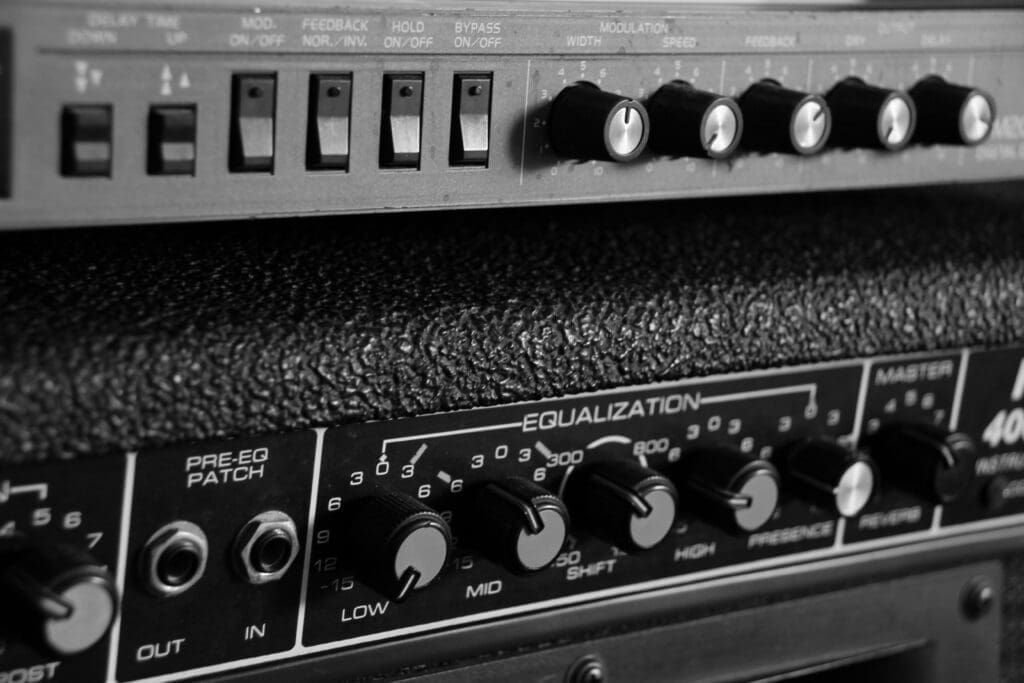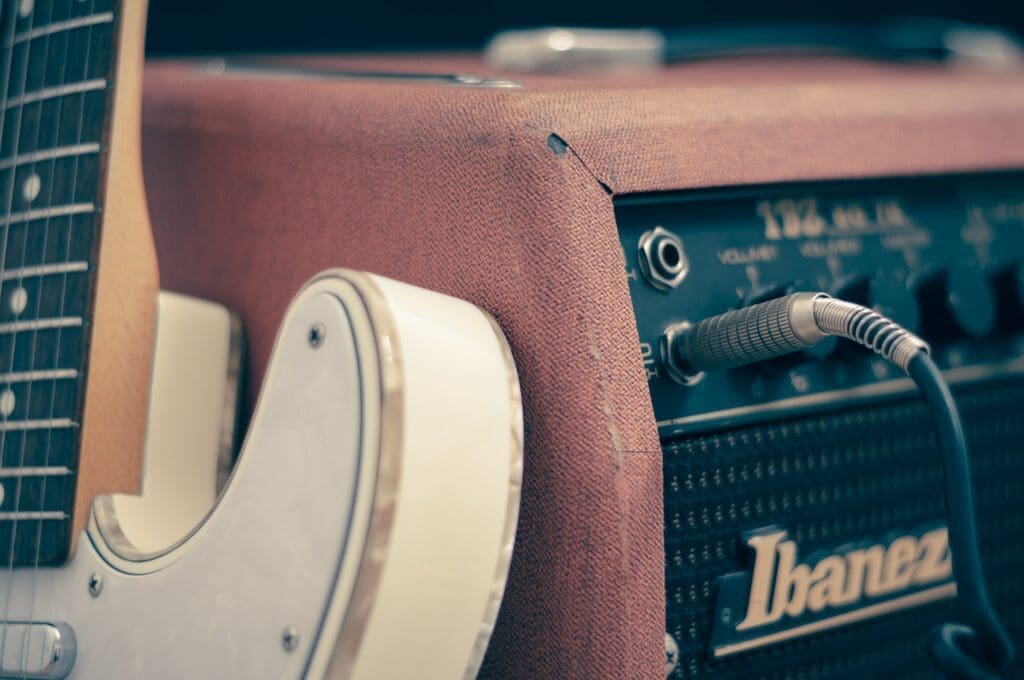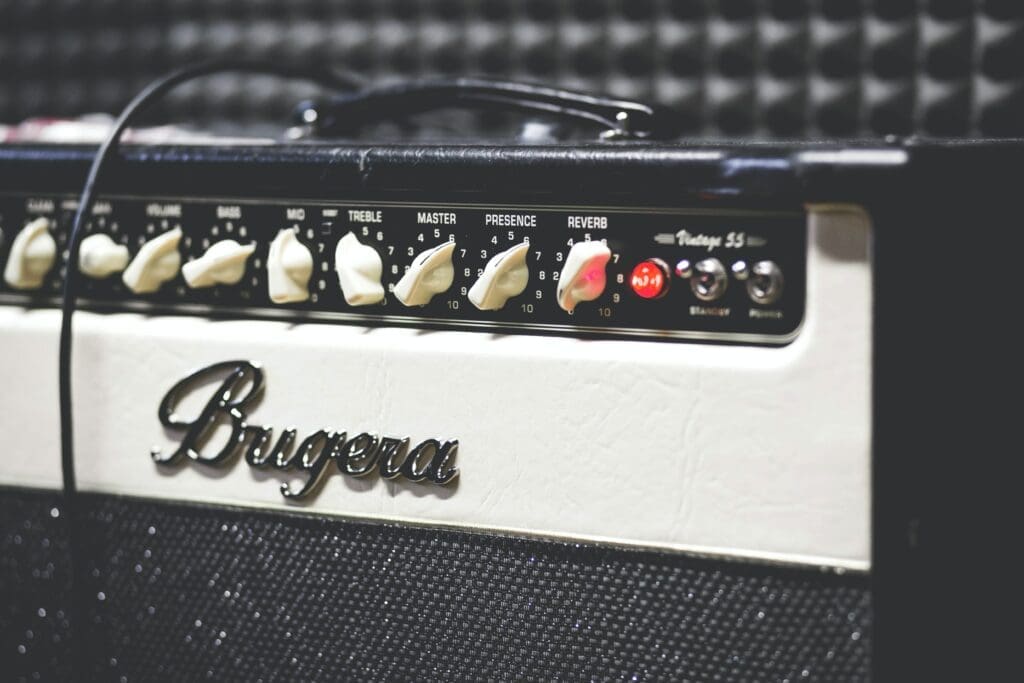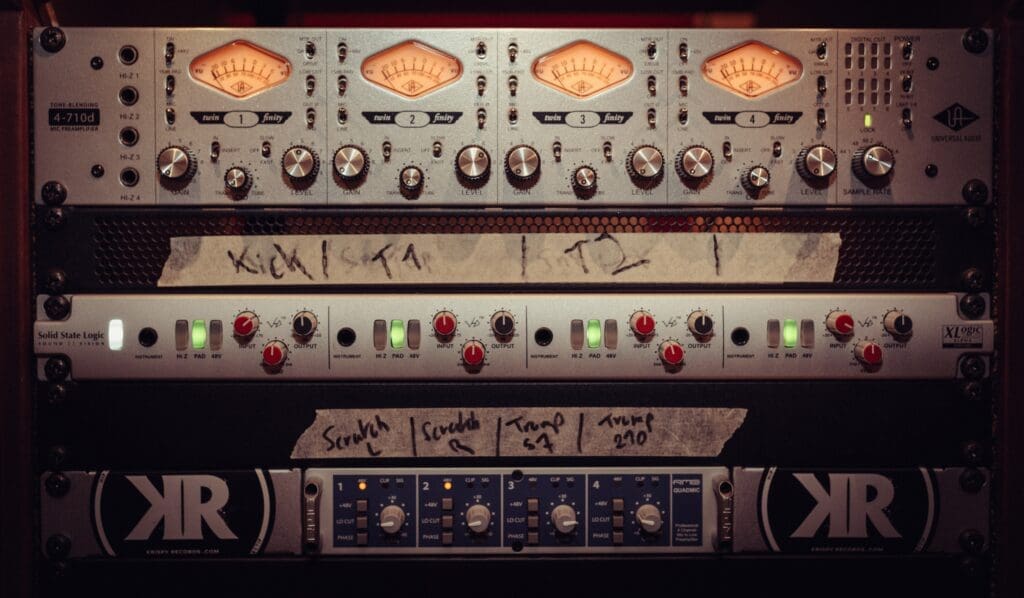Amps are cool. Whether you’re looking to enhance the sound quality of your headphones or craft the perfect tone for your guitar setup, an amplifier has you covered. But where do you start? Understanding the technology behind amplifiers is crucial in understanding where you should start with the whole process.
In this article, we will delve into the world of amplifiers, covering the history, the technology, the different types of amplifiers, what to look out for when buying one, how to maximise your amplifier’s performance, how to troubleshoot common issues, the top 10 amplifiers on the market today, with links to them.
(Hopefully) This blog will make choosing the right amplifier for your needs easy, providing you with the knowledge and resources to make an informed decision. Whether you’re a music enthusiast, a professional musician, or simply looking to enhance your home sound system, understanding amplifier technology is crucial, and this guide will provide you with a comprehensive look at the subject.

A Brief History of Amplifiers
Amplifiers have a long and fascinating history that spans over a century of innovation and discovery.
Early 1900’s
The amplifiers of yore were simple devices (by today’s standards) that used vacuum tubes to amplify electrical signals. They were first developed in the early 1900s and were used primarily in early radio broadcasting and telephony systems. Vacuum tube amplifiers were large and power-hungry, but they provided the necessary amplification needed to transmit signals over long distances.
The 1940’s
The first transistor was invented in the 1940s, which led to the development of transistor-based amplifiers. These were much smaller, more efficient, and more reliable than vacuum tube amplifiers. They quickly replaced vacuum tube technology in many applications, from portable radios to high-end audio equipment.
The 1960’s
In the 1960s, solid-state amplifiers became more common. These were based on transistor technology but used integrated circuits (ICs) to create more complex amplification circuits. Solid-state amplifiers were even more efficient and reliable than earlier transistor-based designs and were used in a wide variety of applications, from guitar amplifiers to medical equipment.
The Present
In recent years, digital amplifiers have become more common. These use digital signal processing technology to convert the original analogue signal into a digital signal, which can then be manipulated and amplified with great precision. Digital amplifiers offer many advantages over traditional analogue amplifiers, including higher efficiency, greater control over the amplified signal, and the ability to perform advanced signal processing and filtering. Amazon Echo and Apple Earpods use this technology.
Amplifiers are an essential part of modern electronic systems, from smartphones to high-end audio equipment to spacecraft. They continue to evolve and improve, with new technologies and designs constantly pushing the boundaries of what’s possible. Whether you’re listening to your favourite music or exploring the depths of space, you can thank our old friend the amplifier for making it possible.
A Little Look at the Technology Behind The Amplifier

If you’re like I was (way back when I first started learning guitar) you may currently be confused by the term “amplifier”, or at the very least, what it is they’re doing.
Amplifiers are one of the most important components of any sound system; yet many people don’t know what they are or how they work – so don’t worry, you’re not alone!
In simple terms, an amplifier is a device that increases the strength of an audio signal. It takes a weak audio signal and makes it louder, so it can be heard through speakers or headphones.
In un-simple terms, it works by taking an audio signal and increasing its voltage or current. The amplified signal is then sent to speakers or headphones, where it is converted back into sound. Amplifiers use transistors or tubes to amplify the signal, with each type of amplifier having its own advantages and disadvantages.
Now don’t worry, I’m not going to go into HUGE detail about these two electronic components, but I’ll give you enough so that you can go away with a more comprehensive view of amplifiers and how they work.
The main difference between the two is that a transistor uses a semiconductor material to control the flow of electricity, while a vacuum tube uses a vacuum and a heated cathode to control the flow of electrons.
Transistors
- An electronic component that can control the flow of electricity.
- Widely used in modern electronic circuits.
- Generally smaller, lighter, and more reliable than tubes.
- Require less power to operate and generate less heat.
- Are often cheaper and more efficient than tube-based amplifiers.
Vacuum tubes
- An electronic component that can control the flow of electricity.
- Used in high-end audio applications because of their ability to produce a warm, natural sound.
- More tolerant of overdriving, which means they can produce a more natural-sounding distortion.
- Usually more expensive.
- Require more power to operate.
The choice between using transistors or tubes in an amplifier often comes down to the application and the desired sound quality. In general, transistor-based amplifiers are preferred for their compact size, efficiency, and low cost, while tube-based amplifiers are preferred for their warm, natural sound quality and ability to handle high input levels without distortion.
What are the Different Types of Amplifiers?

So we’ve had a little look into the technology behind amplifiers, but what are the different types of amplifiers? Well, they’re split into four main types: tube amps, solid-state amps, hybrid amps, and modelling amps.
- Tube amps: Tube amps, also known as valve amps, use vacuum tubes to amplify signals. They are often preferred by guitarists due to their warm, rich sound and responsive feel. Tube amps have a characteristic distortion that many guitarists find desirable, and they are often used in vintage and classic rock music.
- Solid-state amps: Solid-state amps use transistors and other solid-state components to amplify signals. They were developed in the 1950s and quickly became popular due to their compact size and affordability. Solid-state amps are commonly used in modern audio systems, as they offer reliable and efficient amplification that can be tailored to different applications. They are also less susceptible to damage and require less maintenance than tube amps.
- Hybrid amps: Hybrid amps combine the best of both worlds, using a combination of vacuum tubes and solid-state components. These amps offer the warm, rich sounds of tube amps, along with the reliability and efficiency of solid-state amplifiers. Hybrid amps are popular among guitarists who want the best of both worlds and are looking for a versatile amplifier that can be used in different settings.
- Modelling amps: Modelling amps use digital signal processing (DSP) to simulate the sounds of different types of amplifiers and speaker cabinets. They offer a wide range of tonal options, allowing guitarists to experiment with different sounds and styles. Modelling amps are often used by musicians who need a variety of sounds for different applications, such as recording or live performance.
How to Choose an Amplifier

Okay, so we’ve covered a bit about what makes an amplifier amplify, and we’ve talked about its history.
Now onto the bit you’re probably here for.
With so many different types and models on the market, it can be difficult to know which one is right for you. Whether you’re looking for a home sound system, a guitar amp, a piano, or maybe even a PA system for live performances, there are a few things you should keep in mind when choosing an amplifier.
I’ll preface this section with this: sound quality is generally subjective. What I find pleasing, you may not.
You should experiment and try different amplifiers and try to get an informed decision before going out and buying the latest expensive model.
Head down to the guitar or electronics shop and test them out, look at reviews, etc, you get the idea.
All that being said, here are some general things to make a note of when looking for an amplifier.
Choosing the right unit:
- Power Output: The power output of an amplifier is the amount of power it can deliver to a speaker or other output device. This is typically measured in watts, and it’s important to choose an amplifier with a power output that is appropriate for your needs. A larger room or outdoor venue will require more power than a small room or bedroom.
- Number of Channels: The number of channels on an amplifier refers to the number of separate audio signals it can process and amplify simultaneously. A stereo amplifier has two channels, while a surround sound amplifier can have up to 7 channels or more. Choose an amplifier with the appropriate number of channels for your audio system.
Guitar amps will normally have 1 or 2, though. - Input and Output Connections: The input and output connections on an amplifier are important considerations, as they determine what types of devices you can connect to the amplifier. Make sure the amplifier has the appropriate types of inputs and outputs for your audio system.
Again, guitar amps will normally have 1. - Frequency Response: The frequency response of an amplifier is the range of frequencies it can reproduce accurately. It’s important to choose an amplifier with a frequency response that matches the range of frequencies you want to reproduce, whether you’re playing music or speech.
- Build Quality: The build quality of an amplifier is an important consideration, as it can affect the durability and reliability of the amplifier. Look for an amplifier that is well-built and made with high-quality components, as this will ensure it lasts for years to come.
- Price: Of course, price is an important consideration when choosing an amplifier. Make sure to consider your budget and choose an amplifier that offers the best value for your money, without sacrificing quality or features.
*As I was writing this, a colleague of mine was confused about the difference between channels and inputs. If you are as well, then an input is simply a physical connection that allows an audio signal to be fed into a device, whereas a channel is a specific signal path within the amp that is used to process or amplify a particular input signal.
How to Maximise Your Amplifiers Performance

Again: sound quality is generally subjective.
I’m not going to focus on how you can optimise your graphic EQ to the best frequency range for guitar solos, or the best tone configuration for pushing the bass, that’s for another article. What I will focus on are generic steps you can take to maximise any amplifier’s performance.
- Choose the right amplifier for your needs: I won’t expand on this as we’ve just gone through it! But it is important.
- Use high-quality cables and connectors: The cables and connectors you use to connect your amplifier can have a significant impact on its performance. Use high-quality cables and connectors that are appropriate for your system.
- Keep your amplifier cool: Amplifiers can generate a lot of heat, which can affect their performance and longevity. Make sure your amplifier has adequate ventilation and keep it in a cool, well-ventilated space to prevent overheating.
- Keep your amplifier clean: Dust and debris can accumulate inside an amplifier over time, affecting its performance and longevity. Regularly clean your amplifier using a soft cloth and compressed air to remove dust, just as you would a computer.
And don’t forget!
- Avoid clipping: Clipping occurs when an amplifier is pushed beyond its limits, resulting in distorted and unpleasant sounds. Avoid clipping by setting your amplifier’s gain and volume levels appropriately, and use a limiter or compressor to prevent clipping, if you want.
- Pay attention to impedance: So this is a bit of a complicated thing to discuss in a quick summary, but I’ll do my best.
Impedance is a measure of how much a circuit resists the flow of an electrical signal that changes direction, like the signal in an audio system. It is important to match the impedance of components in an audio system, such as speakers and amplifiers, to avoid distortion or damage to the equipment. - Use high-quality power conditioning: Power conditioning sort of goes hand in hand with impedance. A power conditioner is used to safeguard delicate equipment by smoothing out any voltage fluctuations, including spikes, transients, and electrical noise.
How to Troubleshoot Common Amplifier Issues Yourself
Be careful when trying to fix electrical equipment. ALWAYS disconnect the amplifier’s power supply from the mains if you’re taking a look inside the amp.
Now, you’re going to encounter technical issues when dealing with electronics. It’s a fact of life, such as growing old, or that Ray Toro is a criminally underrated guitarist.
Here are some ways you can troubleshoot (and hopefully fix) any issues you’re having with an amplifier:
- No Sound: If your amplifier isn’t producing any sound, the first thing to check is the power supply. Make sure the amplifier is turned on and receiving power. If the power supply is fine, check the cables and connections to the speaker to ensure they are properly connected and functioning.
- Distorted Sound: Distorted sound is often caused by clipping, which occurs when an amplifier is pushed beyond its limits. To fix this issue, adjust the amplifier’s gain and volume levels appropriately, and use a limiter or compressor to prevent clipping.
- Humming or Buzzing: Humming or buzzing sounds can be caused by ground loops, which occur when there are multiple paths for electrical current to flow through. To fix this issue, try disconnecting and reconnecting cables, or use a ground loop isolator.
- Overheating: Overheating can occur when an amplifier is used for extended periods of time at high volumes, or when it is not properly ventilated. To fix this issue, reduce the volume or usage time, or add additional ventilation to the amplifier.
In Addition
- Noisy Controls: If the controls on your amplifier produce noise or static, they may need to be cleaned. Use a cleaning solution designed for electronics and follow the manufacturer’s instructions to clean the controls.
- Dead Channels: If one or more channels on your amplifier aren’t working, it could be due to a problem with the channel’s input, output, or faulty component. Check the input and output connections, and use a multimeter to test the components for proper functionality.
- Blown Fuses: If your amplifier’s fuse blows, it may be due to a power surge or other electrical issue. Replace the blown fuse with a new one of the same type and rating, and check for any other damage or issues.
If you’re still having issues with the amp, contact the manufacturer. It sounds annoying and it’s not a quick fix, but they’ve sorted out issues with my amp many times in the past.
Choosing the best amplifier on the market

So, this may be a bit of a subjective section, but I’ll try and be as objective as possible. When you’re choosing an amplifier, it is important to consider your specific needs and preferences, as well as the features and benefits of each amplifier.
I’m going to include a mixture of guitar amps and home sound system amps for a more mixed recommendation, for whoever may be looking at this article.
- Marshall DSL40CR: The 40W Valve Combo Marshall DSL40CR is a robust amplifier designed for use both on stage and in the studio. It features EL34 valves, which provide an organic and responsive sound and feel. With two gain modes (Classic and Ultra), each with two modes of its own, this amp offers four versatile channels of gain levels to choose from.
You can find it here. - Fender Blues Junior IV: The Blues Junior IV is a highly popular small combo amp known for its warm tone and versatility. It has been updated with modified preamp circuitry, smoother spring reverb, and improved aesthetics, making it even more appealing to guitar players. With its 15-watt power output, this amp is suitable for any setting and perfect for musicians who need to quickly hit the stage or studio.
You can find it here. - Boss Katana 100 MKII: With new voice variations for all five amp characters, the MKII lineup allows for up to five effects to be run simultaneously. Additionally, the inclusion of a power amp input for modellers and multi-FX units adds even more versatility to an already incredible amplifier. This is just the beginning of what the Katana MKII is capable of.
You can find it here. - Yamaha R-S202BL: This amplifier boasts an advanced circuitry design, ensuring high-quality sound reproduction. It also features Bluetooth connectivity, allowing you to easily stream music from your favourite services. The amplifier has a 40-station FM/AM preset tuning, and a frequency response of 10 Hz – 100 kHz (with a deviation of 0 plus/minus 0.5 dB or 0 plus/minus 3.0 dB).
You can find it here. - Crown XLS1502: This amplifier is designed for high energy efficiency, which can result in significant electricity savings. Its enormous headroom ensures that the sound is undistorted and neutral, even at high volumes. It features a limiter in each channel that protects the amplifiers and speakers from level peaks, while protection circuits guarantee reliable operation in case of overload, overheating or short circuits. The amplifier is also incredibly lightweight, making it easy to transport.
You can find it here.
Still can’t decide? Try these:
- Schiit Vidar 2: Vidar is a modern and compact amplifier with a standby switch and a microprocessor-driven system that protects your speakers. With a 600VA transformer, it delivers 100W per channel into 8 ohms, doubling to 200W per channel into 4 ohms. No Class D, no switching supplies, and no fans needed.
You can find it here. - QSC GX5: The GX Series of professional amplifiers delivers performance and portability at an affordable price point. Ideal for professional entertainers seeking a durable and long-lasting amplifier, the GX Series features a lightweight yet robust chassis, meticulous engineering, and advanced overload circuitry to ensure reliable operation.
You can find it here. - Emotiva XPA-2: The XPA-2 Gen3 is a high-quality two-channel power amplifier designed for audiophile enthusiasts. It’s an ideal choice for powering a high-quality stereo or 2.1-channel music system, or the two main channels of a 5.1 or 7.1-channel home theatre system.
You can find it here. - Crown CDi 1000: The Crown CDI-1000 amplifier is perfect for providing outstanding audio quality to any outdoor commercial or landscape project. Its versatility is unmatched, as it’s rated for 2, 4, and 8ohm loads, as well as 70v/100v and 140v outputs. Additionally, the amplifier features onboard digital signal processing, which includes crossovers, EW filters, delay, and output limiting, ensuring the audio is optimised for any environment.
You can find it here. - NAD C 328: The C 328 brings together all the key components of a high-performance music system, accommodating both traditional and modern music sources. With a deep reservoir of power, it enables your speakers to deliver every detail and nuance of your music.
You can find it here.
Closing Thoughts on the Mighty Amplifier
The world of amplifiers is full of variety and possibilities, from vintage tube amps to modern solid-state and transistor amplifiers. By taking into account the key features of an amplifier and following expert tips for maximising performance, you can select an amplifier that best meets your needs and enjoy a high-quality listening experience for years to come.









